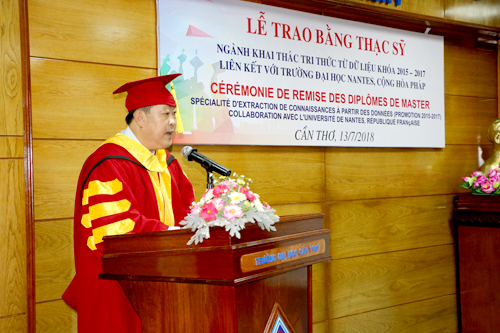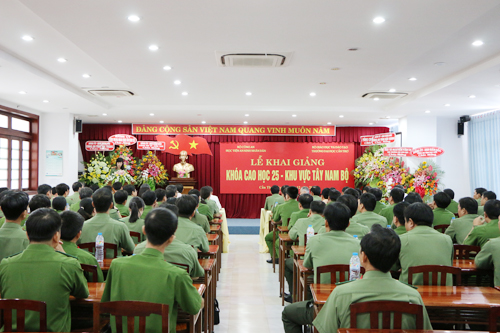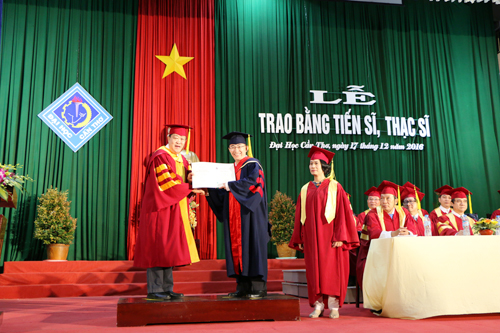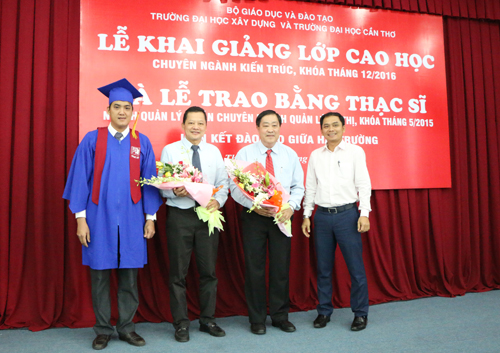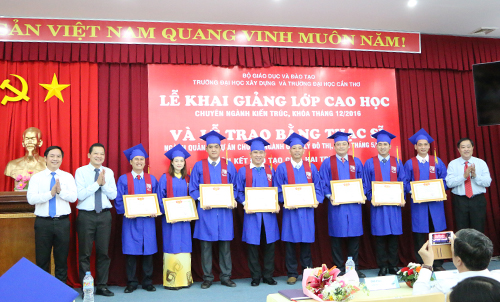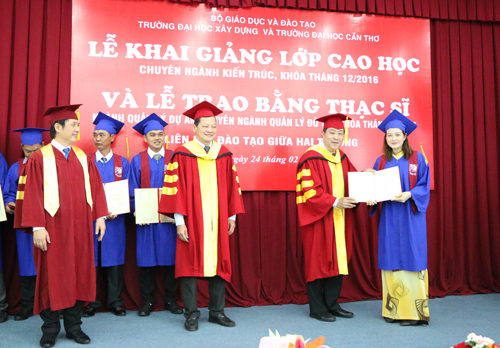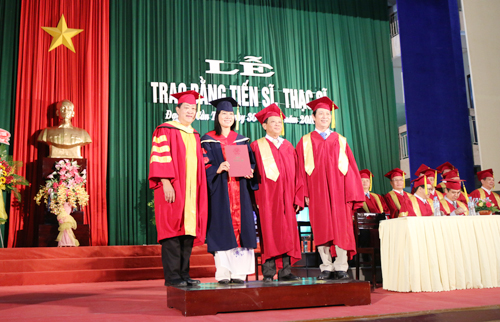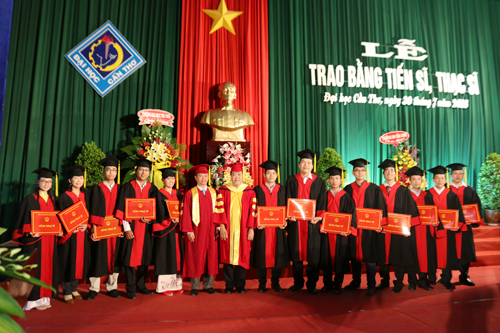
Tên đề tài: “Nghiên cứu công nghệ tổng hợp phức chất puerarin-maltose bằng enzyme Maltogenic amylase và ứng dụng sản xuất nước uống lên men chức năng từ sắn dây và dứa”.
Tác giả: Trần Quốc Bình, Khóa: 2015
Chuyên ngành: Công nghệ thực phẩm; Mã số: 62540101. Nhóm ngành: Công nghệ sản xuất và chế biến
Người hướng dẫn chính: PGS.TS. Lý Nguyễn Bình - Trường Đại học Cần Thơ.
Người hướng dẫn phụ: TS. Lê Quang Trí - Sở Giáo dục và Đào tạo tỉnh Tiền Giang
- Tóm tắt nội dung luận án:
Hợp chất puerarin là một isoflavone có trong củ sắn dây rất tốt cho sức khỏe. Tuy nhiên, thành phần puerarin tự nhiên này có độ tan trong nước thấp nên làm giảm tác dụng của tinh bột sắn dây. Để tăng độ tan của hợp chất này, enzyme Bacillus stearothermophilus maltogenic amylase (BSMA) được sử dụng để biến tính và tạo các dẫn xuất của puerarin tan tốt trong nước. Quá trình biến tính hợp chất puerarin được thực hiện qua hai bước dưới tác dụng lần lượt của enzyme β-amylase và BSMA. Ở mỗi bước, ảnh hưởng của nồng độ cơ chất, pH, nhiệt độ thủy phân, thời gian thủy phân và nồng độ enzyme lên hiệu quả biến tính được khảo sát. Hiệu quả được đánh giá thông qua hàm lượng đường khử và hàm lượng puerarin tổng hợp được.
Luận án bao gồm 3 nội dung chính: (i) Tối ưu hóa quá trình thủy phân tinh bột sắn dây dưới tác dụng của enzyme β-amylase thông qua các yếu tố ảnh hưởng đến hoạt tính xúc tác của enzyme; (ii) Tối ưu hóa quá trình tổng hợp phức chất puerarin-maltose dưới tác dụng của enzyme BSMA thông qua các yếu tố ảnh hưởng đến khả năng xúc tác của enzyme; (iii) Tối ưu hóa quá trình lên men nước dứa-sắn dây thông qua việc khảo sát ảnh hưởng của pH, Brix, tỷ lệ nấm men trong điều kiện lên men ở nhiệt độ thường. Nghiên cứu được bố trí thí nghiệm theo mô hình Box-Behnken và phương pháp bề mặt đáp ứng để tối ưu hóa các điều kiện của quá trình biến tính.
Kết quả nghiên cứu cho thấy, bột sắn dây được thủy phân bằng enzyme β-amylase tốt nhất trong điều kiện tối ưu ở nhiệt độ 54,34°C, thời gian 4,24 giờ, nồng độ β-amylase 41,46 U/g bột có hàm lượng đường khử thu được là 161,07±2,96 mg/g. Về ảnh hưởng của BSMA đến khả năng tổng hợp puerarin, kết quả cũng cho thấy điều kiện tối ưu cho cơ chất tinh bột sắn dây là 57,47°C; 4,05 giờ; BSMA 15,45 U/g bột. Dưới điều kiện tối ưu này, hàm lượng puerarin tổng hợp (khi phân tích bằng sắc ký lỏng cao áp) là 7,51±0,02 mg/g. Trong bước tiếp theo, quá trình lên men nước dứa-sắn dây ở nhiệt độ thường đã được thử nghiệm và tối ưu hóa bằng phương pháp đáp ứng bề mặt kết hợp với thiết kế Box-Behnken với 3 yếu tố chính là pH, Brix và tỷ lệ nấm men. Kết quả thực nghiệm chỉ ra rằng mô hình đa thức bậc hai có thể được sử dụng để tối ưu hóa quá trình lên men để thu được hàm lượng puerarin cao nhất. Puerarin được tối ưu hóa (7,4 mg/g) đã đạt đến hàm lượng dự đoán bởi mô hình tại các điều kiện pH 5,21; 22,12 Brix và tỷ lệ nấm men 11,16%, ngụ ý rằng mô hình phù hợp để dự đoán cho quá trình lên men với độ cồn thu được tương ứng là 6,02. Điểm trọng số trong đánh giá cảm quan được quy định bởi mức độ quan trọng của các yếu tố cấu thành màu sắc, mùi, và vị. Kết quả thống kê cho thấy rằng, với tỷ lệ phối trộn nước dứa và sắn dây 6:4, mẫu lên men đạt điểm cảm quan tổng là 17 điểm (lần lượt là 3,47±0,62; 5,07±0,70; 8,15±0,78 tương ứng cho màu sắc, mùi, và vị). Khi tỷ lệ này được áp dụng cho quá trình lên men ở điều kiện pH 4,5, sản phẩm cuối đạt được mức điểm cảm quan cao nhất 16,09, tương đồng với sản phẩm thương mại.
- Những kết quả mới của luận án:
Đề xuất được phương pháp nghiên cứu và xây dựng thành công quy trình sản xuất nước uống lên men từ dứa đã được làm giàu thêm puerarin với nguồn puerarin chủ động và ổn định thông qua sự tổng hợp puerarin-maltose theo phương pháp enzyme.
Xác định được các thông số tối ưu hóa của quá trình biến tính hợp chất puerarin được thực hiện qua hai bước (1) thủy phân tinh bột sắn dây dưới tác dụng của enzyme β-amylase để tạo dịch thủy phân giàu puerarin; (2) quy trình tổng hợp phức chất puerarin-maltose dưới tác dụng của enzyme BSMA.
Thiết lập được quy trình công nghệ lên men nước dứa có bổ sung phức chất puerarin-maltose từ sắn dây ở quy mô phòng thí nghiệm với các chỉ tiêu chất lượng đáp ứng được tiêu chuẩn Việt Nam (TCVN) cho nước uống có cồn. Từ đó làm cơ sở khoa học cho việc phát triển và đa dạng hóa các sản phẩm giàu dinh dưỡng từ nông sản của ĐBSCL (dứa) và Việt Nam (sắn dây) nói chung.
- Các ứng dụng/khả năng ứng dụng trong thực tiễn, các vấn đề cần tiếp tục nghiên cứu:
- Kết quả nghiên cứu của luận án đóng góp quan trọng trong việc nâng cao giá trị thương phẩm của cây sắn dây và dứa đồng thời đa dạng hóa các sản phẩm nước uống lên men từ trái cây có độ cồn thấp trên thị trường.
- Sản phẩm nước uống lên men từ sắn dây và dứa có khả năng sản xuất ở doanh nghiệp quy mô vừa và nhỏ.
Thesis title: “Research on technology of synthesizing puerarin-maltose complex by Maltogenic amylase enzyme and application of fermented drink production from kudzu roots starch and pineapple juice”
Major: Food technology Code: 62 54 01 01
PhD student: Tran Quoc Binh
Scientific advisor: Assoc. Prof. Dr. Ly Nguyen Binh
Dr. Le Quang Tri
Training Institute: Can Tho University
- Research abstract
Puerarin, the most abundant isoflavone in kudzu root, has been considered as a healthy compound. However, its natural form in kudzu possesses a low water solubility and thus lessens the kudzu flour’s function. To increase its solubility, the Bacillus stearothermophilus maltogenic amylase (BSMA) enzyme was used to modify puerarin and created soluble derivatives. Modification of puerarin was carried out by 2 steps, treated with β-amylase and BSMA respectively. In each step, effects of substrate concentration, pH, hydrolysis temperature, hydrolysis time and enzyme concentration on the modification efficiency were investigated. The effectiveness was measured via reducing sugar content and synthesized puerarin content.
The study includes three main part: (i) Optimization of hydrolysis of kudzu root starch using β-amylase with the reducing sugar content produced as a function of substrate concentration, pH, temperature, time and enzyme concentration. (ii) Optimization of the synthesized puerarin-maltose complex under the catalysis of BSMA enzyme through investigating the effects of pH, temperature, time and concentration of BSMA enzyme. (iii) Optimization of mixed pineapple juice puerarin-maltose fermentation through investigating the effects of pH, soluble content, yeast counts under the fermentation at ambient temperature. The Box-Behnken design and response surface methodology were applied to optimize the derivation of puerarin.
The research results showed that the kudzu starch was hydrolyzed with the best β-amylase enzyme under optimal conditions at the temperature of 54.34°C, the time of 4.24 hr, the concentration of β-amylase 41.46 U/g powder with the content of reducing sugar obtained is 161.07±2.96 mg/g. On the effect of BSMA on the ability to synthesize puerarin, the optimal conditions were 57.47°C, 4.05 hr, and 15.45 U/g kudzu starch. The derived puerarin content analyzed by High Performance Liquid Chromatography (HPLC) was 7.51±0.02 mg/g. In next step, the fermentation of mixed pineapple juice-kudzu juice under ambient temperature was conducted and optimized by response surface method combined with Box-Behnken design with 3 main factors: pH, Brix and yeast level. The results indicated that the quadratic polynomial model can be used to optimize the fermentation to obtain the highest level of puerarin. The optimized puerarin (74 mg/g) reached the concentration predicted by the model at conditions pH 5.21, 22.12 Brix and yeast ratio of 11.16%, implying that the model is suitable for prediction of the concentration of the fermentation process with the resulting alcohol content of 6.02. The weighting score in the sensory assessment is determined by the importance of the factors constituting color, odor, and taste. Statistical results show that, with the mixing ratio of pineapple juice and kudzu 6:4, the fermented samples achieved a total sensory score of 17 points (3.47±0.62; 5.07±0.70; 8.15±0.78 for color, odor, and taste, respectively). As this ratio was applied for a fermentation process at the pH level of 4.5, the fermented product obtained the highest total sensorial score of 16.09, in accordance with commercial products.
- The new findings of the dissertation
Proposing a research method and successfully building a process to produce fermented drink from pineapple enriched with puerarin with an active and stable source of puerarin through enzymatic synthesis of puerarin-maltose.
Determining the optimization parameters of the puerarin denaturation process was done through two steps (1) hydrolyzing kudzu starch under the action of β-amylase enzyme to produce hydrolysate rich in puerarin; (2) process of synthesizing puerarin-maltose complex under the action of BSMA enzyme.
The technological process of pineapple juice fermentation with the addition of puerarin-maltose complex from kudzu has been established at a laboratory scale with the quality criteria meeting the Vietnamese standards (TCVN) for alcoholic beverages. From there, it serves as a scientific basis for the development and diversification of nutritious products from agricultural products of the Mekong Delta (pineapple) and Vietnam (kudzu) in general.
- Application/applicability in practice and further studies
- The research results of the thesis make an important contribution in improving the commercial value of kudzu and pineapple and at the same time diversifying low alcoholic fruit-fermented drinks on the market.
- Products fermented drinks from cassava and pineapple can be produced in small and medium-sized enterprises.
- Xem chi tiết nội dung luận án
- Xem thông tin đăng tải tại Website Bộ giáo dục và Đào tạo. (Nhập tên NCS vào ô tìm kiếm)





